The small rivers macrogroup consists of the following aquatic habitat types:
Low Gradient, Cold, Small Rivers
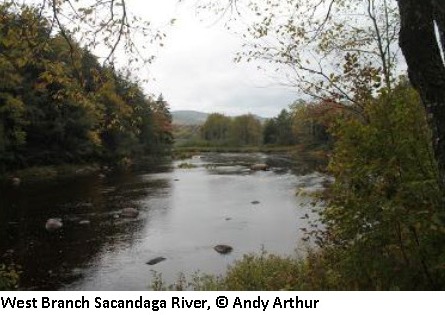
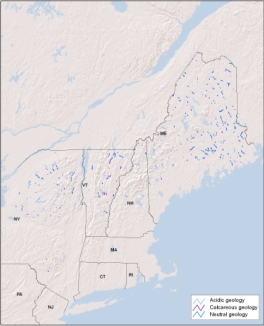
Distribution:
ME, NH, NY, VT. 989 miles of habitat in the region, of which 24.6% of the 100m riparian buffer is conserved.
Description:
Cold, slow-moving, small rivers of flat, marshy settings at high elevations or in areas of substantial cold groundwater inflow. These small rivers of northern regions drain watersheds up to 200 sq.mi and have an average bankfull width of 72 feet. The slow- moving waters are dominated by runs with interspersed pool sections and a few short or no distinct riffles. Their substrate is usually dominated by silt, sand, and fine gravel, and they may exhibit high turbidity and be somewhat poorly oxygenated. These low-gradient rivers are often described as unconfined and have moderate to high sinuosity with broader valleys. They are typically surrounded by floodplain forest, wetlands, or eroded sand or clay banks or fine sediment bars. Permanent cold water temperatures in these rivers means coldwater fish species, such as brook trout, likely represent over half of the fish community. Additional variation in the biological community is associated with acidic, calcareous, and neutral geologic settings where the pH of the water will limit the distribution of certain macroinvertebrates, plants, and other aquatic biota.
Download the
pdf for this habitat for information about species, crosswalks to state names, and condition of this habitat.
Low Gradient, Cool, Small Rivers
Download the
pdf Guide for this habitat.
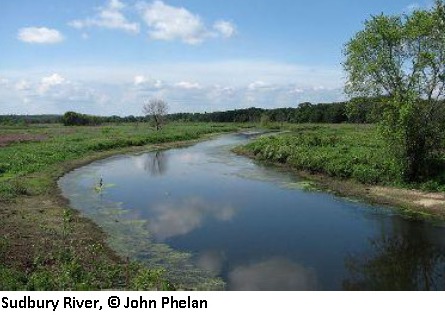
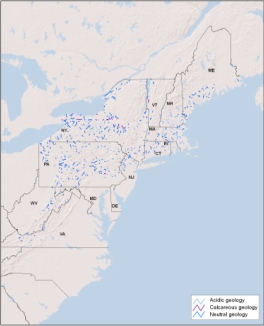
Distribution:
CT, ME, MD, MA, NH, NJ, NY, PA, RI, VT, VA, WV. 2,416 miles of habitat in the region, of which 13.4% of the 100m riparian buffer is conserved.
Description:
Cool, slow-moving, small rivers of flat, marshy settings at low to moderate elevations. These small rivers drain small watersheds of up to 200 sq.mi. in size and have an average bankfull width of 65 feet. The slow-moving waters are dominated by runs with interspersed pool sections and a few short or no distinct riffles. Their substrate is usually dominated by silt, sand, and fine gravel, and they may exhibit high turbidity and be somewhat poorly oxygenated. These low-gradient rivers are often described as unconfined and have moderate to high sinuosity with broader valleys. They are typically surrounded by floodplain forest, wetlands, or eroded sand or clay banks or fine sediment bars. Cool water temperatures in these rivers means the fish community will contain a higher proportion of cool and warm water species relative to coldwater species. There will be less habitat with cool enough temperatures to support coldwater species year round. Additional variation in the biological community is expected in acidic, calcareous, and neutral geologic settings where the pH of the water will limit the distribution of certain macroinvertebrates, plants, and other aquatic biota.
Download the
pdf for this habitat for information about species, crosswalks to state names, and condition of this habitat.
Low Gradient, Warm, Small Rivers
Download the
pdf Guide for this habitat.

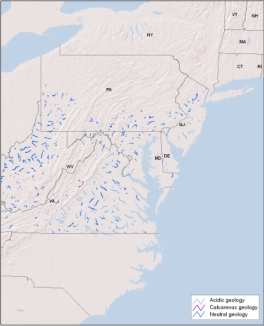
Distribution:
DE, MD, NJ, NY, PA, VA, WV. 2,488 miles of habitat in the region, of which 9.1% of the 100m riparian buffer is conserved.
Description:
Warm, slow-moving, small rivers of flat, marshy settings at low elevations and throughout the southern Mid-Atlantic. These small rivers of southern regions, drain watersheds up to 200 sq.mi and have an average bankfull width of 62 feet. The slow-moving waters are dominated by runs with interspersed pool sections and a few short or no distinct riffles. Their substrate is usually dominated by silt, sand, and fine gravel, and they may exhibit high turbidity and be somewhat poorly oxygenated. These low-gradient rivers are often described as unconfined and have moderate to high sinuosity with broader valleys. They are typically surrounded by floodplain forest, wetlands, or eroded sand or clay banks or fine sediment bars. Warm water temperatures in these rivers means the fish community will contain a higher proportion of warmwater species relative to coolwater species. These systems are unlikely to support any resident coldwater species. Additional variation in the biological community is expected in acidic, calcareous, and neutral geologic settings where the pH of the water will limit the distribution of certain macroinvertebrates, plants, and other aquatic biota.
Download the
pdf for this habitat for information about species, crosswalks to state names, and condition of this habitat.
Moderate Gradient, Cold, Small Rivers
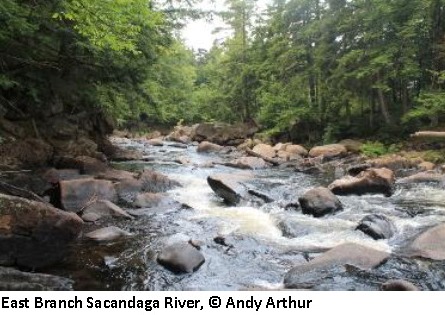
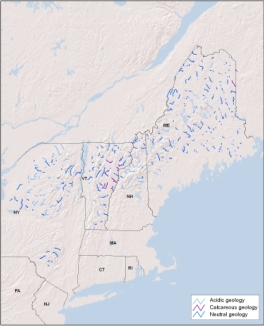
Distribution:
ME, NH, NY, VT. 2,352 miles of habitat in the region, of which 23.8% of the 100m riparian buffer is conserved.
Description:
Cold, moderately fast-moving, small rivers at high elevations or in areas of substantial cold groundwater inflow. These small rivers of the northern region drain watersheds up to 200 sq.mi and have an average bankfull width of 69 feet. The moderately fast-moving waters are dominated by a well-defined pattern of alternating pools, riffles, and runs. Their substrate is dominated by sand, gravel, and cobble, and they often have high water clarity and are well oxygenated. These moderate gradient rivers exhibit moderate to low sinuosity with moderately narrow valleys and adjacent riverside upland communities. Cold water temperatures in these rivers means coldwater fish species, such as brook trout, likely represent over half of this fish community. Additional variation in the biological community is expected in acidic, calcareous, and neutral geologic settings where the pH of the water will limit the distribution of certain macroinvertebrates, plants, and other aquatic biota.
Download the
pdf for this habitat for information about species, crosswalks to state names, and condition of this habitat.
Moderate Gradient, Cool, Small Rivers

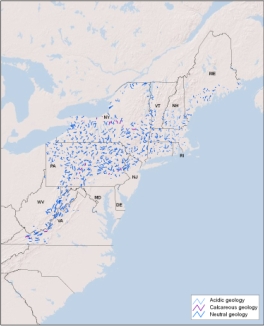
Distribution:
CT, ME, MD, MA, NH, NJ, NY, PA, RI, VT, VA, WV. 6,343 miles of habitat in the region, of which 11.1% of the 100m riparian buffer is conserved.
Description:
Cool, moderately fast-moving, small rivers at moderate to low elevations in the north and at higher elevations in the south. These small rivers drain watersheds up to 200 sq.mi and have an average bankfull width of 62 feet. The moderately fast-moving waters are dominated by a well-defined pattern of alternating pools, riffles, and runs. Their substrate is composed of sand, gravel, and cobble, and they often have high water clarity and are well oxygenated. These moderate gradient rivers exhibit moderate to low sinuosity with moderately narrow valleys and adjacent riverside upland communities. Cool water temperatures in these rivers means the fish community will support few permanent coldwater species and will contain a higher proportion of cool and warm water species relative to coldwater species. Additional variation in the biological community is expected in acidic, calcareous, and neutral geologic settings where the pH of the water will limit the distribution of certain macroinvertebrates, plants, and other aquatic biota.
Download the
pdf for this habitat for information about species, crosswalks to state names, and condition of this habitat.
Moderate Gradient, Warm, Small Rivers
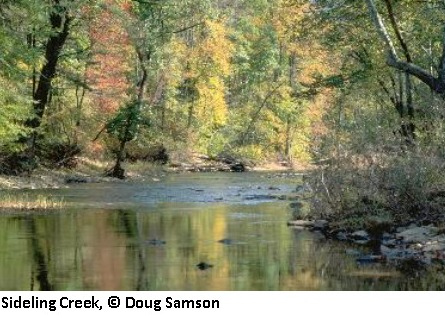
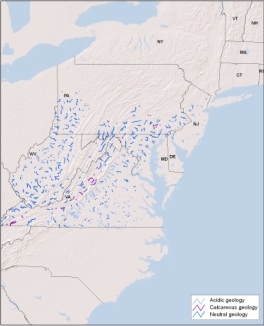
Distribution:
DE, DC, MD, NJ, NY, PA, VA, WV. 3,664 miles of habitat in the region, of which 8.3% of the 100m riparian buffer is conserved.
Description:
Warm, moderately fast-moving, small rivers of the southern Mid- Atlantic region. These small rivers of the south drain watersheds up to 200 sq.mi and have an average bankfull width of 69 feet. The moderately fast-moving waters are dominated by a well-defined pattern of alternating pools, riffles, and runs. Their substrate is composed of sand, gravel, and cobble, and they often have high water clarity and are well oxygenated. These moderate gradient rivers exhibit moderate to low sinuosity with moderately narrow valleys and adjacent riverside upland communities. Warm water temperatures in these rivers means the fish community will contain a higher proportion of warmwater species relative to coolwater species. These systems are unlikely to support any resident coldwater species. Additional variation in the biological community is expected in acidic, calcareous, and neutral geologic settings where the pH of the water will limit the distribution of certain macroinvertebrates, plants, and other aquatic biota.
Download the
pdf for this habitat for information about species, crosswalks to state names, and condition of this habitat.